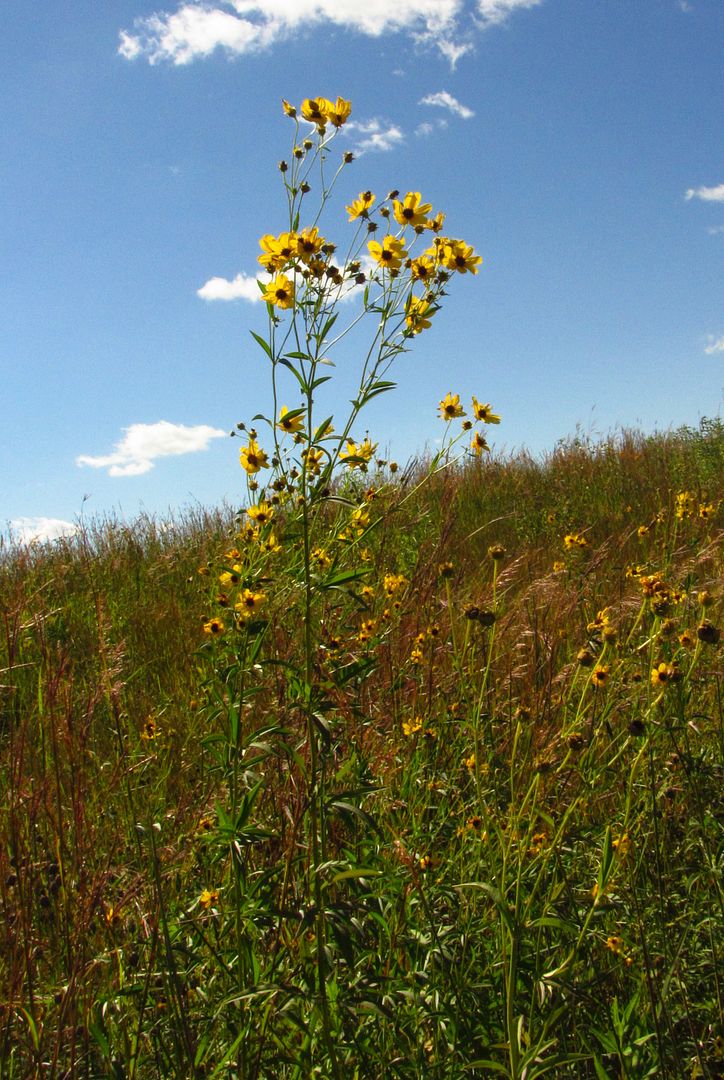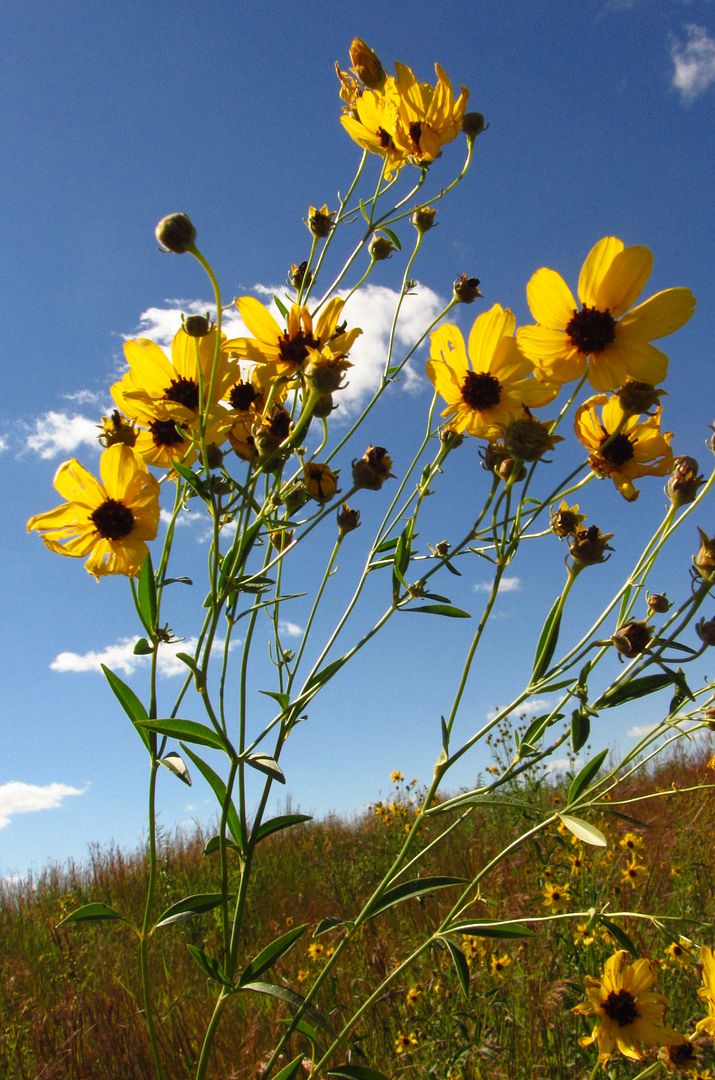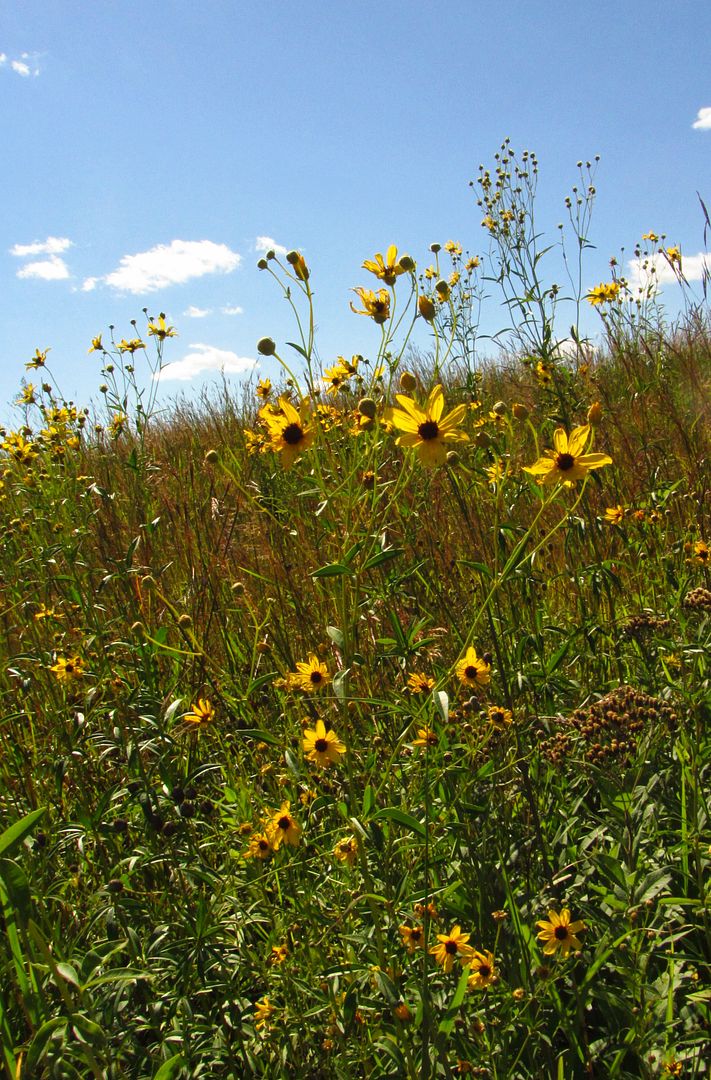I haven’t featured enough prairie wildflowers this summer. The Neal Smith National Wildlife Refuge (Jasper County), Whiterock Conservancy (Carroll County), and Kuehn Conservation Area (Dallas County) are some of my favorite prairie outings within easy striking distance of Des Moines. Within the Des Moines city limits, the plantings around Gray’s Lake are the best place to find prairie natives. I took all of the pictures enclosed below at the Neal Smith refuge.
This week’s featured plant is native to much of the eastern U.S. and Canada. Tall coreopsis (Coreopsis tripteris) lives up to its name, growing up to eight or nine feet in height. Like many prairie wildflowers, it’s a member of the aster family with yellow ray flowers. Distinguishing it from other tall plants in the same family is straightforward. Cup plants and compass plants have completely different leaves, don’t branch much near the top, and have yellow center disks rather than brown ones, like tall coreopsis. Ox-eye flowerheads have yellow centers too, and the plants rarely grow taller than four to five feet.
Tall coreopsis is also known as tall tickseed. According to the Missouri Botanical Garden website, “Plants in the genus Coreopsis are sometimes commonly called tickseed in reference to the resemblance of the seeds to ticks.”
This post is a mid-week open thread: all topics welcome.
At the U.S. Wildflowers website, Gerry Wilkinson notes, “While most Coreopsis species are 3 feet tall or shorter, this plant can be 8 or more feet tall.” The Missouri Botanical Garden website says this plant is good for rear borders of gardens, because of its height. I had trouble capturing the plant in its entirety, but this shot gives you a sense of its scale.
Here’s a closer view of the tops of the plant, where the flowerheads are. (In contrast, compass plants also have blooms lower on the stems.)
The Illinois Wildflowers website has a detailed description of tall coreopsis foliage and flowers and describes where the plant thrives:
This plant isn’t particular about soil type, and can be found growing in soil containing substantial amounts of loam, clay-loam, gravel, or sand. Tall Coreopsis tolerates competition from other plants and it is easy to grow. In moist disturbed locations, it can become aggressive. Mature plants tolerate some drought, and foliar disease is rarely a significant problem.
[…] Habitats include black soil prairies, cemetery prairies, sand prairies, typical savannas and sandy savannas, thickets, edges of seeps, thinly wooded bluffs, meadows in wooded areas, limestone glades, abandoned fields, areas along railroads, and roadsides. Tall Coreopsis occurs in moderately disturbed to high quality habitats. It responds well to fire in areas that have been invaded by shrubby vegetation and trees.
The Missouri Botanical Garden site has more advice for those who aspire to cultivate tall coreopsis:
Easily grown in dry to medium moisture, well-drained soil in full sun. Thrives in poor, sandy or rocky soils with good drainage. Plants grown in dry soils tend to be shorter, open and somewhat spindly. Plants grown in medium moisture soils with consistent moisture tend to be taller and fuller. Tolerant of heat, humidity and drought. Prompt deadheading of spent flowers may encourage additional bloom and prevents any unwanted self-seeding. Freely self-seeds, and in optimum growing conditions will naturalize to form large colonies.
This picture shows a small part of a large colony of tall coreopsis, along one of the trails near the Neal Smith National Wildlife Refuge visitor’s center.
In this shot, lots of big bluestem (one of the most common tallgrass prairie grasses) is visible growing among the tall coreopsis.




